Our replica Moon has been on display for about a month now. As I helped create the information panels labeling craters and maria on the Moon, I found myself wondering, “Why does this particular crater have that name?” “Who picked the names anyway?” As it turns out, the names of features on the Moon are not fully random; there was a system for naming them–at least for some of those on the near side.

Michael van Langren published the first map of the Moon with named features in 1647. Although only three of his names survive on their original craters, it was van Langren who introduced the term ‘mare’ (Latin for ‘sea’) for the large, dark regions he saw on the Moon. Johannes Hevelius published another map in 1649. We no longer use Hevelius’ names for craters or maria, which were based on geographical features of Earth. Some of his names for lunar mountain ranges, though, do survive. However, the map which served as the basis for modern names of most lunar features (“selenography”) was that of Giovanni Riccioli and Francesco Grimaldi in 1651. (Grimaldi drew the map, while Riccioli named the features.) We use Riccioli’s names for the maria, and of his 210 crater names, only 23 have failed to survive until the present day.

Representation of Giovanni Battista Riccioli as found in the Atlas Coelestis (1742) of Johann Gabriel Doppelmayr. Source: Wikimedia Commons.
Riccioli named the maria based on folklore which associated the first quarter Moon with good weather and the last quarter Moon with bad weather. Accordingly, the maria visible at first quarter Moon include the Seas of Serenity, Tranquility, Fertility, and Nectar. At last quarter Moon, on the other hand, we see the Sea of Rains, Sea of Clouds, Sea of Moisture, and the Ocean of Storms.
One mare that seems not to fit that pattern is the Sea of Crises, which is near the Seas of Tranquility and Fertility. However, the Greek word krisis, borrowed into Latin and then English as ‘crisis’, originally meant an act of separating or distinguishing. This may explain the name Mare Crisium, as this is the first mare revealed as each New Moon becomes a crescent.
One more mare, extending across the northern part of the lunar disk, Riccioli dubbed the Sea of Cold.
What about the craters?
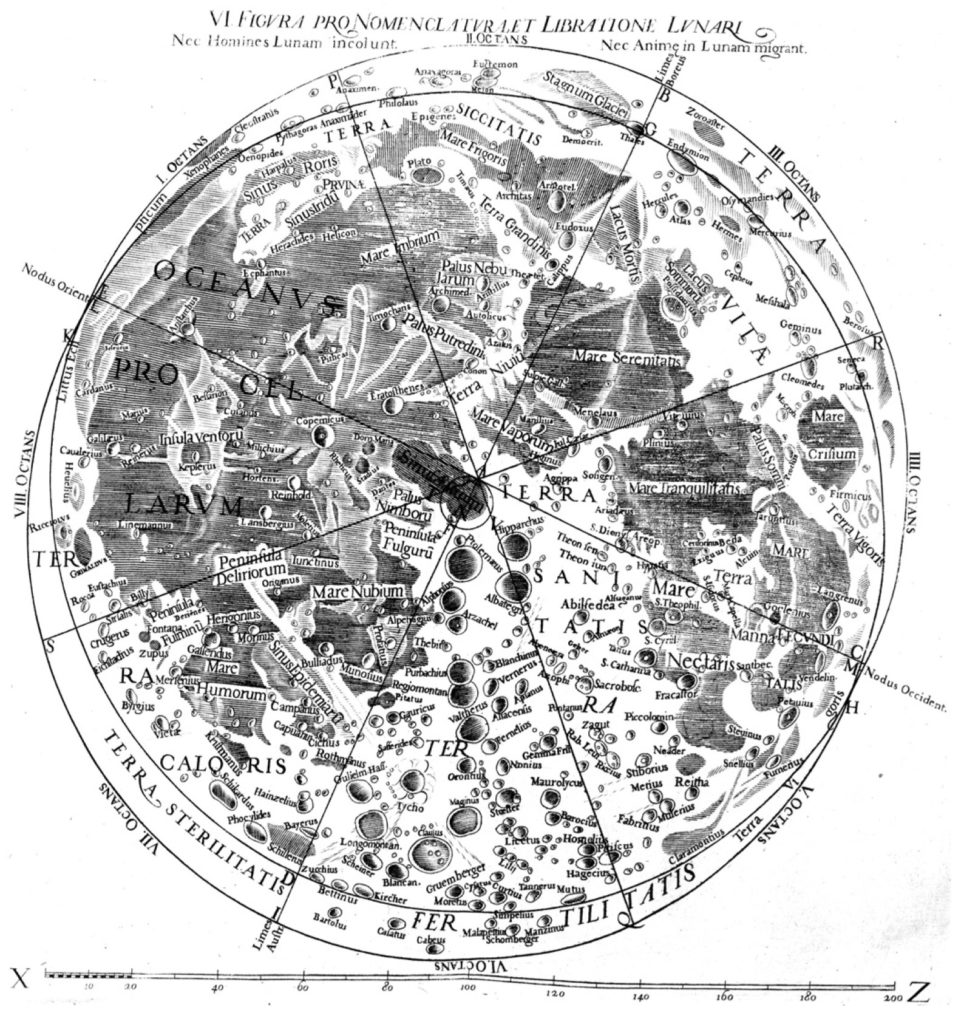
Map of the Moon from G. B. Riccioli’s 1651 Almagestum Novum. Source: Wikimedia Commons.
If you look at the Riccioli map here, you see that he divided the Moon’s visible face into eight octants, arranged like pie slices that meet at the center of the lunar disk. Riccioli numbered the octants clockwise around the disk. From the center of the Full Moon, octant 1 extends up and to the left, octant 2 straight up, octant 3 up and to the right, 4 straight to the right, 5 down and to the right, 6 straight down, 7 down and to the left, and 8 straight to the left.
Taking the names octant by octant in this order, we see they are roughly in chronological order, from famous names of deep antiquity in octants 1-3 to contemporaries of Riccioli in octants 6-8. Thus for example, octant 1 has Eratosthenes and Pythagoras while octant 2 has Plato, Aristotle, and Archimedes. In octant 3, van Langren had named a crater for Endymion, a mythical lover of the Moon goddess Selene. Riccioli kept that name and added others from myth, including Atlas, who held up the sky, and Hercules who temporarily filled in for Atlas while Atlas helped in one of Hercules’ labors.
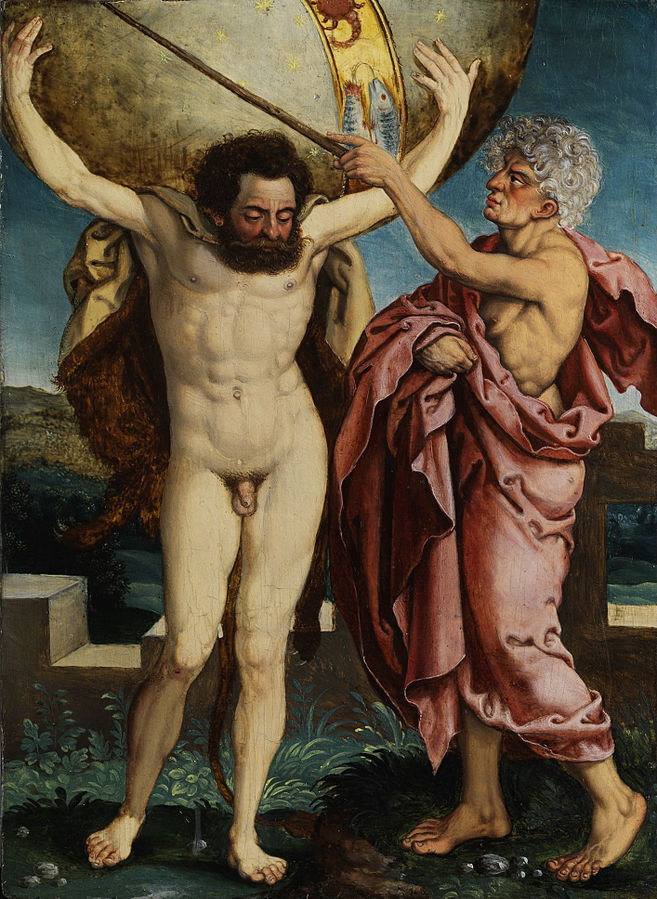
Hercules holding up the sky for Atlas (based on Heinrich Aldegrever, 1550). Source: Wikimedia Commons.
Moving around to octants 4 and 5, we see names from the period when Rome was becoming preeminent. Julius Caesar has a crater here due to his work in correcting the Roman calendar. Hipparchus, who discovered the precession of the equinoxes, is in octant 5. The one exception to this whole pattern is Langrenus, named after van Langren. That’s because while Riccioli changed virtually all of van Langren’s names in order to fit his system, he chose to honor van Langren by leaving van Langren’s own name on the Moon, right where van Langren himself put it.
In octant 6, we see that Riccioli acknowledged Muslim contributions to astronomy. Arzachel, for example, is in fact the great Muslim astronomer Al-Zarqali. Nearby is Albategnius, or Al-Battani in Arabic. Out towards the limb of the Moon as we see it, in this same section, we come to astronomers who deeply influenced Riccioli himself, such as Tycho Brahe and the German astronomer Christopher Clavius.
The most interesting octant, though, is #8, which extends across the Ocean of Storms. The names Riccioli placed here reveal how wrong he was about the universe. By 1651, educated astronomers no longer accepted the ancient Ptolemaic model in which the Sun, Moon, and planets all orbit a stationary Earth. Rather, the debate was between the Copernican model, in which Earth is one of the planets which rotate and orbit the Sun, and the model of Tycho Brahe. Danish astronomer Tycho Brahe had proposed a model of the solar system in which all planets orbit the Sun…..which orbits the Earth (as does the Moon). This model is, of course, wrong, but it was quite attractive to deeply religious astronomers of the time who wanted explain planetary motions better than Ptolemy while remaining loyal to the church. Riccioli was among those who preferred Tycho’s model to that of Copernicus. Accordingly, he gave Tycho’s name to the most prominent crater he could see, with long, bright rays extending from it, as if Tycho were enlightening the other scientists on the Moon.
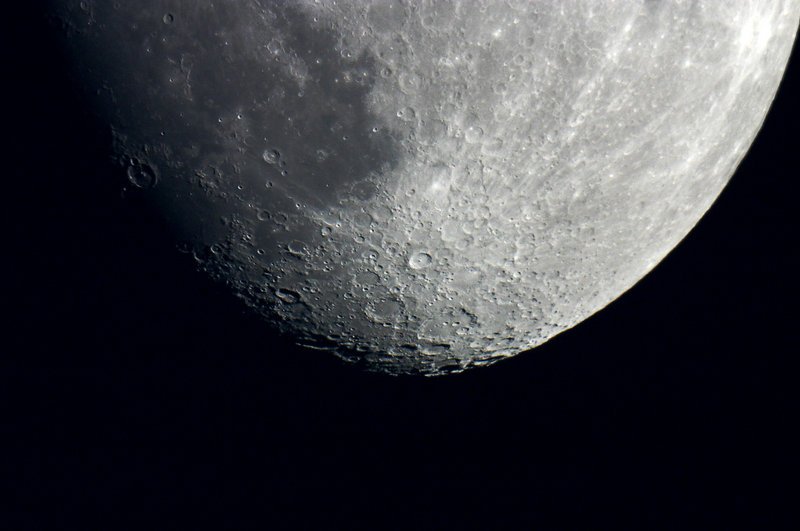
Tycho is the deep crater near center with the point in the middle. The rays emanate from it. It is named after the astronomer Tycho Brahe. Author: Joe Huber. Source: Wikimedia Commons.
Meanwhile, Riccioli placed the Copernicans he knew—those who correctly understood that the Earth rotates on its axis and revolves around the Sun–in octant 8, so they would be in “stormy waters”. Thus, the craters Copernicus and Kepler are here. Galileo is too, on a much smaller crater. Riccioli had assigned Galileo’s name to a bright lunar swirl we now call ‘Reiner Gamma’ (because Grimaldi mistakenly drew it as a crater). Once it was known not to be a crater, Galileo’s name was moved to the nearest actual crater, which happened to be quite small.
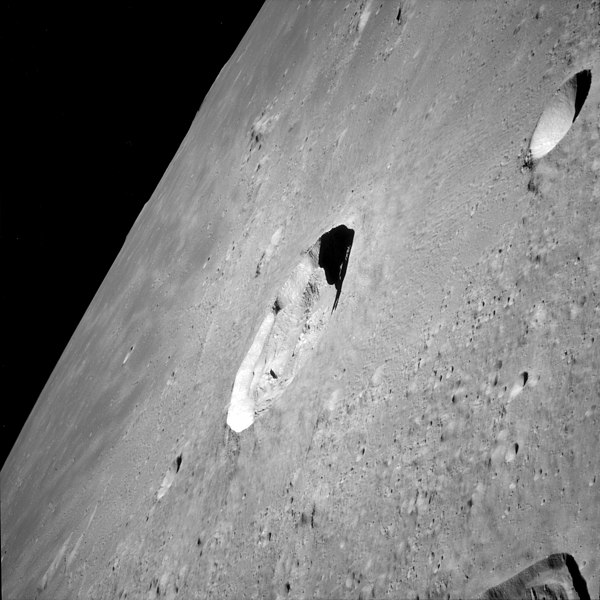
In this orbital view from Apollo 12, Kepler crater is the large crater at center, as viewed from the south. It is surrounded by a skirt of high albedo material giving it a relatively light appearance. Source: Wikimedia Commons.
Incidentally, some ancient Greek astronomers, such as Aristarchus, had proposed in antiquity that Earth orbits the Sun. Thus Aristarchus’ crater is in octant 1 with other ancients, but right on the border with octant 8. Yes, Riccioli put him, too, in the Ocean of Storms.
Why did Riccioli’s names persist? Well, the short answer is that later selenographers (lunar map-makers) simply kept using them. And that’s because Riccioli’s map is simple and it was easy to add names to it. If you look at his map carefully, you’ll see that he left many small craters unnamed. It was easy for someone to just keep Riccioli’s names and add in luminaries from between Riccioli’s time and their own. For example, Johann Schröter’s map in 1791 added 70 names (including Issac Newton). Johann Mädler and Wilhelm Beer added over 130 names in 1836 (including Benjamin Franklin). All these names, along with the rule that newly discovered craters be named after famous scientists, became official when the International Astronomical Union (IAU) published its list in 1935.
Thus, when scientists finally saw the polar regions and the far side of the Moon, they continued to use the names of scientists and space flight pioneers. This was often done thematically, although without a full system of octants like Riccioli’s. For example, the crater at the South Pole is called Shackleton, after Antarctic explorer Ernest Shackleton. Nearby craters honor Amundsen and Scott.
Mare Moscoviense, identified in pictures taken by the USSR’s Luna 3 probe, was the first mare seen on far side. Craters near it honor Russian and Soviet cosmonauts. Also on the far side is the giant crater Apollo. Craters in and around it are named for the crew of Apollo 8, the first to see this side of the Moon directly, and for the crews of Apollo 1, Challenger, and Columbia, those lost while exploring space. Also here is Dryden, honoring a former Deputy Director of NASA who helped inspire Kennedy to start the Apollo program.
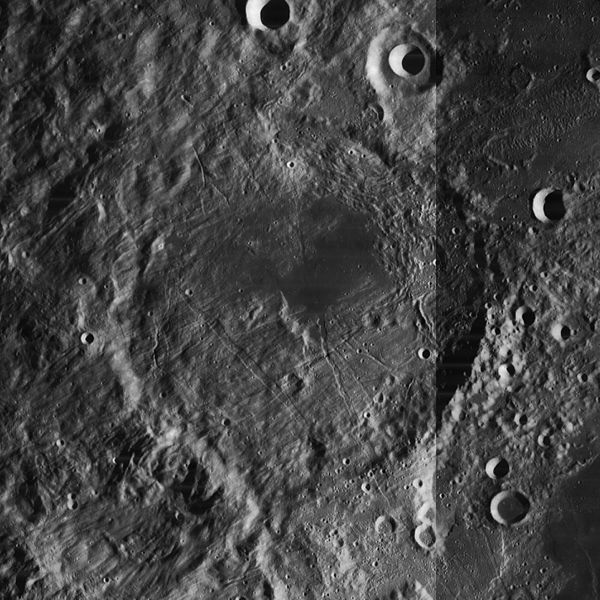
Riccioli, on the moon.
Author: James Stuby based on NASA image. Source: Wikimedia Commons.
Naturally, Riccioli assigned craters to himself and to Grimaldi. These two craters are far on the left side of the Moon’s disk as seen from Earth. Think of how an artist might put his own name in the margins of his masterpiece, taking credit but keeping himself out of the way. We’ve labeled those two craters on our Western Hemisphere map rather than on the near side, as they’re easier to see from there. The crater Langrenus is clear on the other side of the lunar disk; we’ve labeled it on our Eastern Hemisphere map. How many other craters discussed here can you find on our model Moon?
HMNS will be hosting our magnificent model moon all summer in honor of the 50th anniversary of the Apollo 11 moon landing. Come check it out, in addition to the moon installation, we also have a lunar walk VR experience and actual footage from the Apollo missions being projected in the wall to our own specially curated “moon music mix”. It all makes for a a cool atmosphere to hang out, pose for pictures and experience our nearest celestial neighbor like never before.
Further Reading:
The Moon Has Landed at HMNS! Or At Least a Giant Model Has…
Educator How-To: Making the Moon Out of Cheese (and Crackers)!
Lost of Forgotten Houston History: Sports Addition
Doing American History Wrong: How I Won at Independence Hall





